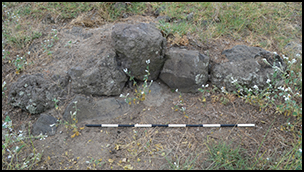Crossref Citations
This article has been cited by the following publications. This list is generated based on data provided by
Crossref.
Erb-Satullo, Nathaniel L.
Jachvliani, Dimitri
Kakhiani, Kakha
and
Newman, Richard
2020.
Direct evidence for the co-manufacturing of early iron and copper-alloy artifacts in the Caucasus.
Journal of Archaeological Science,
Vol. 123,
Issue. ,
p.
105220.
Robinson, Abby
and
Khaburzania, Giorgi
2020.
Highland Fortress Complexes and Riverine Borders in Samtskhe-Javakheti, Southwest Georgia.
Journal of Eastern Mediterranean Archaeology and Heritage Studies,
Vol. 8,
Issue. 3-4,
p.
345.
Lau, Hannah
Proctor, Lucas
Gopnik, Hilary
and
Bakhshaliyev, Veli
2020.
Agropastoralism in middle bronze through early iron age Naxçıvan: Zooarchaeological and paleoethnobotanical data from Qızqala.
Journal of Archaeological Science: Reports,
Vol. 33,
Issue. ,
p.
102535.
Erb-Satullo, Nathaniel L.
2021.
Technological rejection in regions of early gold innovation revealed by geospatial analysis.
Scientific Reports,
Vol. 11,
Issue. 1,
Erb-Satullo, Nathaniel L.
and
Jachvliani, Dimitri
2022.
Fortified Communities in the South Caucasus: Insights from Mtsvane Gora and Dmanisis Gora.
Journal of Field Archaeology,
Vol. 47,
Issue. 5,
p.
305.
Von Suchodoletz, Hans
Kirkitadze, Giorgi
Koff, Tiiu
Fischer, Markus L.
Poch, Rosa M.
Khosravichenar, Azra
Schneider, Birgit
Glaser, Bruno
Lindauer, Susanne
Hoth, Silvan
Skokan, Anna
Navrozashvili, Levan
Lobjanidze, Mikheil
Akhalaia, Mate
Losaberidze, Levan
and
Elashvili, Mikheil
2022.
Human-environmental interactions and seismic activity in a Late Bronze to Early Iron Age settlement center in the southeastern Caucasus.
Frontiers in Earth Science,
Vol. 10,
Issue. ,
Ardelean, Adrian Cristian
Sărășan, Adriana
Bălărie, Andrei
Akmatov, Kunbolot
Tabaldiev, Kubatbek
and
Wehrheim, Ruben
2023.
Above ground and underground – An integrated approach of the burial mounds within the Suusamyr plateau, Kyrgyzstan.
Archaeological Research in Asia,
Vol. 35,
Issue. ,
p.
100463.
Lindsay, Ian
and
Mkrtchyan, Arshaluys
2023.
Free and Low-Cost Aerial Remote Sensing in Archaeology.
Advances in Archaeological Practice,
Vol. 11,
Issue. 2,
p.
164.
Erb-Satullo, Nathaniel L.
Rutter, Matilda
Frahm, Ellery
Jachvliani, Dimitri
Albert, Paul G.
and
Smith, Victoria C.
2023.
Obsidian exchange networks and highland-lowland interaction in the Lesser Caucasus borderlands.
Journal of Archaeological Science: Reports,
Vol. 49,
Issue. ,
p.
103988.
Mariani, Guido S.
Brandolini, Filippo
and
Melis, Rita T.
2024.
Mining, farming, and diplomacy. Understanding the human landscape of Bronze Age Sardinia (Italy) through geospatial analysis.
Quaternary Environments and Humans,
Vol. 2,
Issue. 5,
p.
100025.
Losaberidze, Levan
Kirkitadze, Giorgi
Akhalaia, Mate
Lobjanidze, Mikheil
Zimmerman, Michael
and
Elashvili, Mikheil
2024.
New insights into complex social organization in the southern Caucasus – Late Bronze Age–Early Iron Age settlement patterns in the Shiraki Plain (southeast Georgia).
E&G Quaternary Science Journal,
Vol. 73,
Issue. 2,
p.
145.
Cobb, Peter J.
Cobb, Elvan
Azizbekyan, Hayk
Petrosyan, Artur
and
Gasparyan, Boris
2024.
Defending the Vedi River Valley of Armenia: The Fortification and Refortification of a Flatland-Mountain Interface.
Bulletin of the American Society of Overseas Research,
Vol. 392,
Issue. ,
p.
151.
Chazin, Hannah
2025.
Animal power: Re-thinking cattle and caprines’ roles in Late Bronze Age political life in the South Caucasus.
Journal of Anthropological Archaeology,
Vol. 77,
Issue. ,
p.
101630.
Erb-Satullo, Nathaniel L.
Jachvliani, Dimitri
Higham, Richard
Weber-Boer, Kathryn O'Neil
Symons, Alex
and
Portes, Ruth
2025.
Mega-fortresses in the South Caucasus: new data from southern Georgia.
Antiquity,
Vol. 99,
Issue. 403,
p.
150.
Chazin, Hannah
2025.
Herding in mountain pastures: diverse isotopic biographies across species in the Late Bronze Age South Caucasus.
Archaeological and Anthropological Sciences,
Vol. 17,
Issue. 4,
